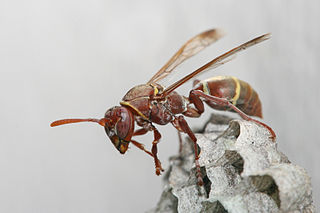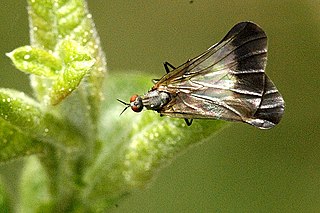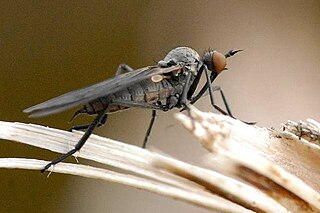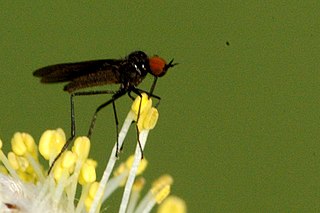
Flies are insects of the order Diptera, the name being derived from the Greek δι- di- "two", and πτερόν pteron "wing". Insects of this order use only a single pair of wings to fly, the hindwings having evolved into advanced mechanosensory organs known as halteres, which act as high-speed sensors of rotational movement and allow dipterans to perform advanced aerobatics. Diptera is a large order containing more than 150,000 species including horse-flies, crane flies, hoverflies, mosquitoes and others.

Mayflies are aquatic insects belonging to the order Ephemeroptera. This order is part of an ancient group of insects termed the Palaeoptera, which also contains dragonflies and damselflies. Over 3,000 species of mayfly are known worldwide, grouped into over 400 genera in 42 families.

The Polistinae is a subfamily of eusocial wasps belonging to the family Vespidae. They are closely related to the wasps and true hornets of the subfamily Vespinae, containing four tribes. With about 1,100 species total, it is the second-most diverse subfamily within the Vespidae, and while most species are tropical or subtropical, they include some of the most frequently encountered large wasps in temperate regions.

The family Leptoceridae are a family of caddisflies often called "long-horned caddisflies" or "silverhorns". Leptoceridae is the second largest family of caddisflies with over 1850 species in approximately 68 genera. The main identifying feature of most Leptoceridae is that their antennae are much longer than those of other caddisflies. There is one genus with relatively short antennae (Ceraclea), but it is easily identified by the pair of dark curved lines on the mesonotum.

Empididae is a family of flies with over 3,000 described species occurring worldwide in all the biogeographic realms but the majority are found in the Holarctic. They are mainly predatory flies like most of their relatives in the Empidoidea, and exhibit a wide range of forms but are generally small to medium-sized, non-metallic and rather bristly.

Ropalidia marginata is an Old World species of paper wasp. It is primitively eusocial, not showing the same bias in brood care seen in other social insects with greater asymmetry in relatedness. The species employs a variety of colony founding strategies, sometimes with single founders and sometimes in groups of variable number. The queen does not use physical dominance to control workers; there is evidence of pheromones being used to suppress other female workers from overtaking queenship.

Rhamphomyia is a genus of dance flies, in the fly family Empididae. It contains more than 600 species in 8 subgenera.

Rhamphomyia sulcata is a species of dance flies, in the fly family Empididae. It is included in the subgenus Rhamphomyia. It is found in most of Europe, except the Balkan Peninsula.

Rhamphomyia albidiventris is a species of dance flies, in the fly family Empididae. It is included in the subgenus Pararhamphomyia. It has a limited distribution. It has been recorded from Great Britain, Germany, Austria, Slovakia, Bosnia, Finland and central Russia.

Rhamphomyia crassirostris is a species of dance flies, in the fly family Empididae. It is found in most of Europe, east to Poland and Hungary. It is absent from Italy and the Balkan Peninsula.

Rhamphomyia flava is a species of dance flies, in the fly family Empididae. It is found in most of Europe, except the Iberian Peninsula and most of the Balkan Peninsula.

Rhamphomyia nigripennis is a species of dance flies, in the fly family Empididae. It is found in most of Europe, except France, Italy, Croatia, Bosnia, Greece, Albania, Romania, Ukraine and Belarus

Rhamphomyia pilifer is a species of dance flies, in the fly family Empididae. It is found in most of Europe, except the Balkan Peninsula and the Iberian Peninsula.

Rhamphomyia simplex is a species of dance flies, in the fly family Empididae. It has a limited distribution. It is known from Ireland, east to Germany and from Sweden, Finland and north-west Russia.

Empis borealis is a species of dance flies in the fly family Empididae. It is found in most of Europe, except the Balkan Peninsula, the Baltic Region and the Iberian Peninsula. The brown wings of the female are very broad, while the male fly’s wings are narrower.

Empis ciliata, the black dance fly, is a species of dance fly, in the fly family Empididae. It is included in the subgenus Euempis.

Sexual selection in insects is about how sexual selection functions in insects. The males of some species have evolved exaggerated adornments and mechanisms for self-defense. These traits play a role in increasing male reproductive expectations by triggering male-male competition or influencing the female mate choice, and can be thought of as functioning on three different levels: individuals, colonies, and populations within an area.

Empidinae, also called dance flies, are a subfamily of empidoid flies. They are mainly predatory flies like most of their relatives, and generally small to medium-sized. Most species are flower visitors and they can be effective pollinators.

Rhamphomyia longicauda, the long-tailed dance fly, is a species of fly commonly found in eastern North America that belongs to the family Empididae and part of the superfamily of dance flies Empidoidea. It is included in the subgenus Rhamphomyia. This species of fly is most known for sex role reversal during courtship, as females put on exaggerated displays and congregate in leks to attract males. Females cannot hunt for food, so they receive protein from nuptial gifts brought to them by males. Female dependence on males for nutrition is the principal cause for sex role reversal in this species of fly.
Chironomus annularius is a species of non-biting midge in the family Chironomidae. It is usually found in regions with bodies of fresh water but can be found in almost every environment. It tends to form "hotspots" around specific areas. The species is distinguished by the size of its chromosomes and the lack of a proboscis.


















